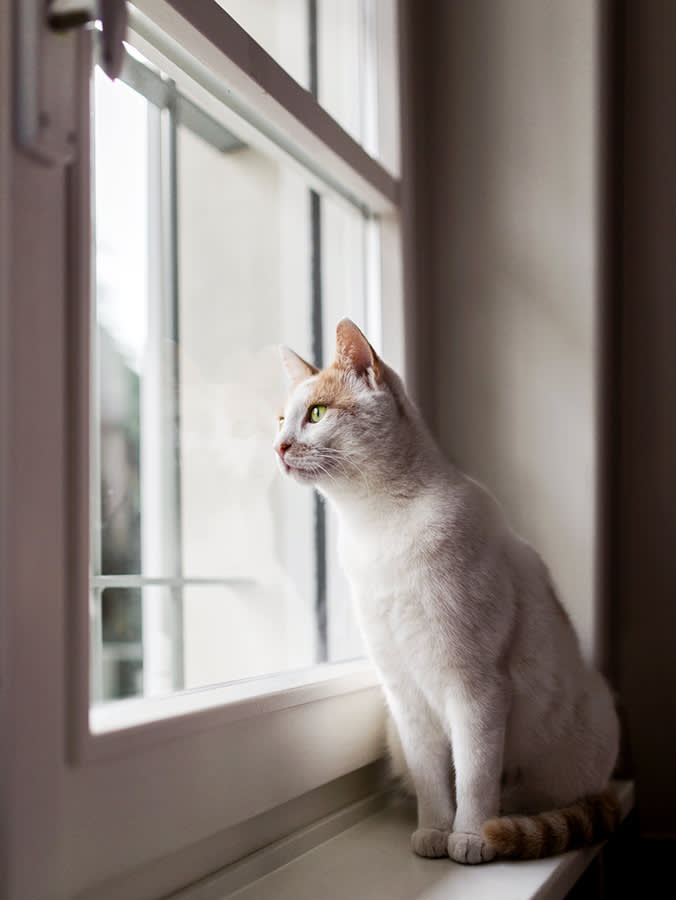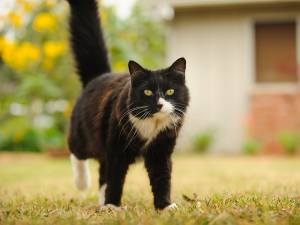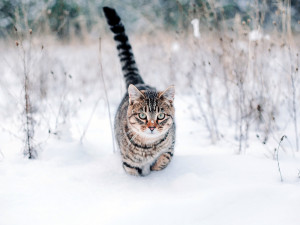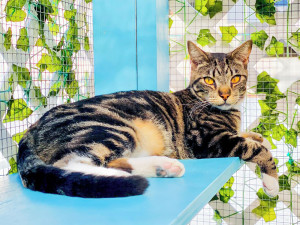Your Cat Wants to Go Outside More Than Anything — Should You Let Them?
The pros and cons of letting your cat explore the neighborhood (and beyond).

share article
Here’s one of the first things you learn as a cat parent: They want you to feel guilty that they won’t let you outside. They look out the window with longing, watching birds and squirrels (and maybe other cats) walk freely down the street. Maybe they even stand at the door and make sad noisesopens in a new tab, wondering about the world outside, like even now, when it’s probably way too cold for them out thereopens in a new tab.
Cats are natural explorersopens in a new tab and hunters, so common sense says they could benefit from a little time outdoors in the right weather conditions, right? While some cat parents choose to let their cat wander and return home for meals and a warm place to sleep, there are a lot of dangers that even part-time outside cats face. It’s important to weigh the benefits of letting your cat explore on their own versus the many risks before you throw the door wide open.
Why do cats want to go outside?
If your cat has ever darted toward an open door, you may have a feline who just isn’t satisfied with the indoor life. Just like humans, every cat’s personality is different, and whether your cat is desperate to explore the outdoors or content to lounge in a windowsillopens in a new tab depends on their disposition.
“Some cats really enjoy having access to the outdoors, while others are perfectly content staying strictly indoors,” certified feline behavior consultant and Collective memberopens in a new tab Cristin Tamburo says. “Outdoor time provides an excellent means of mental stimulation for cats and can greatly reduce any boredom. Time outdoors also allows them to exercise more natural behaviors, which can be both good and bad.”
Cats have strong predator instincts, and even if they’re well-fed, they may feel driven to hunt, as well as mark their territory against any potential interlopers. And in your cat’s mind, their territory may extend well beyond the house to the surrounding neighborhood — which makes being stuck inside feel especially unfair.
“One of the primary advantages of letting cats outside is that they get to be cats!” cat behaviorist Marci Koskiopens in a new tab of Feline Behavior Solutionsopens in a new tab says. “Cats evolved in an outdoor environment and are programmed to explore, hunt, and play. While it’s possible to provide our cats with environmental enrichment opportunities indoorsopens in a new tab, it’s very difficult to replace the enrichment that cats get from being outdoors where there are constant stimuli for the five senses.”
Dangers of letting your cat outdoors
Going outside on their own can make your cat much more vulnerable to a whole host of dangers, from getting struck by a car, attacked by another animal, or even stranded in a tree (yes, it happens).
“It’s imperative to understand that cats who are let outside face life-threatening risks that are generally not present for indoor-only cats,” Koski says. “Cats who are let outside (especially unsupervised) risk getting killed or injured by cars, animals, or other people. Further, they can get sick with serious illnesses transmitted by other cats or contract parasites from the environment, such as fleasopens in a new tab.”
If you’re considering letting your cat outside, take some time to think about the potential risks and determine if they’re worth the advantages for your cat.
“Cats who roam are exposed to many dangers, including vehicles, predators, parasites, and disease,” certified cat behavior consultantopens in a new tab and author Marilyn Krieger says. “It is important to also consider the neighbors as well as the wildlife. Outdoor cats trigger indoor cats to develop problematic behaviors.”
Disease
Just as humans are more likely to get sick when around other humans, your outdoor cat has a much larger chance of contracting a disease, some of which can be fatal. Your cat may meet other outdoor cats who might not be vaccinated or may be suffering from an illness that they can pass on to your cat. Some common diseases your cat may encounter in their journeys are:
Feline leukemia (FeLV)
Feline AIDS (FIV)
Feline distemper
Feline infectious peritonitis (FIP)
Parasites
Less life-threatening but still no fun, your cat can also attract a host of parasites outdoors, such as fleas, ticks, ear mites, and gastrointestinal worms. Worst of all, they may contract ringwormopens in a new tab, which is a skin infection that can be passed between species. Parasites can be a huge pain to get rid of and cause unpleasant symptoms like skin infections, vomiting, and diarrhea, not just in your cat, but in humans in your household, too.
Safety
No matter how street-smart you think your cat is, the outside world is full of threats. Cats don’t have the instincts to avoid traffic and are often struck by carsopens in a new tab. And while they may be as skilled as Katniss Everdeen on a hunt, they sometimes end up being hunted, attacked by feral cats, loose dogs, or wild animals like coyotes, foxes, or even alligators, depending on where you live.
Yes, curiosity can even kill a cat, especially if they end up exploring a garage or other building that has toxic chemicals like antifreeze or rat poison. And while the image of a cat stuck up a tree is adorable in cartoons, cats sometimes climb to places they can’t get down from, leaving them stranded for days and, in some cases, suffering from severe dehydration or potentially deadly falls.
Environmental impact
A cat’s prey drive is so strong that, even if they’re happily fed, they may hunt birds and other small animals just for fun. While one cat going on a hunting spree isn’t a big deal, the number of cats on the streets has had a devastating impact on bird and small mammal populations, with cats killing hundreds of millions of birds each year.
“Cats are among the world’s most skilled hunters, which they do for food and fun,” Koski says. “Domestic cats are not native predators in much of the world, which may mean that the predator/prey dynamic favors these small non-native cats. Many people feel it is irresponsible to let these predators outside to prey on native wildlife populations with which domestic cats did not evolve, particularly if there are threatened or endangered species in the area.”
A recent study found that cats eat more than 2,000 speciesopens in a new tab of wildlife, of which almost 350 species require conservation efforts. That’s right: stray and outdoor cats could be the reason that some birds and small animals are in danger of extinction.
Benefits of letting your cat spend time outside
While there are many dangers to letting your cat roam the neighborhood, there are a few benefits to outside time for your pet which are worth considering — even if you don’t plan to let your cat out unsupervised.
Regular exercise
Cats who are free to explore get much more exercise and are more likely to maintain a healthy weight. However, the advantage of exercise is overshadowed by the dangers of animal attack or being struck by a car, so you may want to look for ways to keep your cat physically active while inside.
Physical and mental stimulation
Curious cats can enjoy the physical and mental stimulation of exploring the world, which may help limit behavioral issues when they’re in the house. But with the right toys and activities, your cat can receive plenty of stimulation while safely indoors, so make sure to set time aside to play with your catopens in a new tab. Bonus: This is a great bonding experience for both of you.
How to let your cat outdoors safely
While pet parents want to guarantee their cat’s safety, there’s no way to do so if you let them outside. But Dr. Koski notes that there are some precautions cat parents can take to help keep their animal safer, short of keeping their cat indoors at all times, like having proper identification, such as a microchipopens in a new tab and a collar with an ID tag.
“Many people try to keep their cats indoors at dusk, night, and dawn, when the risks of other predators might be higher,” Dr. Koski says. “If you can, it’s always good to be able to supervise your cat when they are outdoors, or at least keep them in a contained area.”
If you want your cat to enjoy going outside but still protect them from the world’s many potential threats, consider leash-training your catopens in a new tab. Many cats enjoy spending supervised time outside on a harness and leashopens in a new tab, and you can ensure that your cat explores the world safely.
Some cat parents invest in an outdoor patio opens in a new tab— known as a “catio” — which is a screened-in play area for their cat. These structures can vary in size, from a small, window-attached box to a shed-size building attached to the house so your cat can easily go in and out.
“I built my catio when my kittens were still tiny, and it’s the favorite part of my apartment for them and me!” Tamburo says. “A catio can be an enclosed patio or balcony or even a secure enclosure. This gives them independent, constant access to the outdoor space, while keeping them safe and secure from any dangers.”
If you don’t have the space or budget to build a full-blown catio, Tamburo recommends investing in an enclosure or collapsible setup, which you can find online.
“There are many solutions for both enclosures and safe fencing,” Krieger adds. “Enclosures and cat-fenced yards need plenty of enrichment, including places to climbopens in a new tab and hide.”
Keeping your indoor cat happy
The indoor life doesn’t have to be a bore for your cat. With the right toys and entertainment, your cat can lead a physically and mentally stimulating life without the threat of speeding cars and wild animals. Here are a few things you can do to help keep your indoor cat happy:
Adopt another catopens in a new tab: If you don’t have the time or resources for another pet, then stick with one, but if you can, consider adopting another cat as a playmate for yours. Some cats even get along well and enjoy playing with dogsopens in a new tab.
Invest in interactive toysopens in a new tab: Try a variety of toys and take time to play with your cat.
Scatter scratching posts around the house: Not only can these posts help with a cat’s natural instinct to scratch, but they can also protect your furnitureopens in a new tab.
Create climbing areas: Cat treesopens in a new tab and perches are significantly safer than trees.
Turn on “cat TV”: Install bird feeders or baths within view of the windows so your cat can enjoy the show (without attacking).
With outdoor enclosures like catios, interactive toys, and regular playtime, there are plenty of ways you can ensure your cat gets physical and mental stimulation without stressing about their safety. Before you open the door for your cat to adventure through the neighborhood, consider alternative solutions and ways to entertain your cat in a safe environment.
References:

Savannah Admire
Savannah Admire is a writer, poet, and pet mom to three dogs and a cat. She currently lives in Western Maryland. When she’s not writing, you can find her reading, taking photos, or volunteering as a content creator for her local community theatre. Her debut poetry book, Mother Viper, is due out August 12, 2025, and you can follow her on Instagram at @savannahcooperpoetopens in a new tab.
Related articles
![Striped cat walking through the snow.]() opens in a new tab
opens in a new tabHow to Make an Outdoor Cat House for Winter
Channel your inner HGTV star and build a feline fixer-upper.
![A fluffy cat sitting outside in the snow.]() opens in a new tab
opens in a new tabHow Cold is Too Cold For Outdoor Cats?
Be a good neighbor and learn to spot the signs of frostbite in your community cats.
![Cat sitting on a sky blue ledge with plant vines in the background]() opens in a new tab
opens in a new tabHow to DIY a Catio
Cat behaviorist Cristin Tamburo’s tips for building a safe outdoor space for your cat.
![A Burma breed cat on a leashed harness sitting near a feet of a girl at a pedestrian crossing.]() opens in a new tab
opens in a new tabHow to Walk Your Cat on a Leash
Adventure Cats author Laura Moss’s step-by-step guide for hitting the streets with your cat.
![Training a cat sitting with leash and harness on.]() opens in a new tab
opens in a new tabA Step by Step Guide on How to Clicker Train Your Cat
This popular training technique isn’t just for dogs. Here’s how you can use it for your cat.
![Cat sitting in a field wearing a pink harness and leash.]() opens in a new tab
opens in a new tabThe Best Cat Harnesses of 2024
Safe and stylish gear to turn your local trail into a catwalk.









